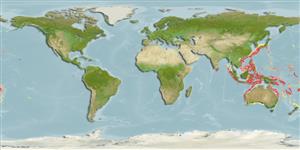Classification / Names
Common names from other countries
Main reference
Size / Weight / Age
Max length : 18.5 cm SL male/unsexed; (Ref. 5403)
Environment
Marine; demersal; depth range 150 - 400 m (Ref. 5403)
Climate / Range
Deep-water, preferred ?
Distribution
Short description
Dorsal
spines
(total): 10;
Dorsal
soft rays
(total): 13;
Anal
spines: 3;
Anal
soft rays: 13 - 14. Medium-sized fish. The body is oval; dorsal fin continuous; eyes very large; mouth large and oblique, with the lower jaw projecting upwards. The head and body silvery red or pink; iris of eyes red. The fins are creamy pink; the last 4-5 soft rays of the dorsal and anal fins are clearly white. This species resembles P. macracanthus with a long and narrow preopercular spine, but has less body depth, a narrower caudal peduncle, and fainter yellowish spots on its dorsal, anal and pelvic fins.
IUCN Red List Status (Ref. 115185)
Threat to humans
Harmless
Human uses
Fisheries: of no interest
More information
Common namesSynonymsMetabolismPredatorsEcotoxicologyReproductionMaturitySpawningFecundityEggsEgg development
ReferencesAquacultureAquaculture profileStrainsGeneticsAllele frequenciesHeritabilityDiseasesProcessingMass conversion
Tools
Special reports
Download XML
Internet sources
Estimates of some properties based on models
Phylogenetic diversity index
PD50 = 0.5002 many relatives (e.g. carps) 0.5 - 2.0 few relatives (e.g. lungfishes)
Trophic Level
3.9 ±0.6 se; Based on size and trophs of closest relatives
Resilience
High, minimum population doubling time less than 15 months (Preliminary K or Fecundity.)
Vulnerability
Low vulnerability (15 of 100)
Price category
